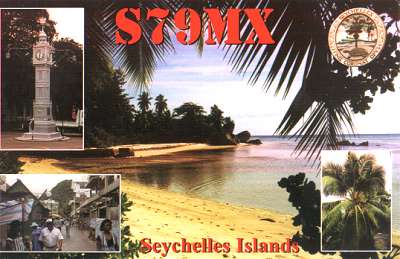Kurt Bindschedler, HB9MX
Issue 65, May 2000
 The
six-metre band has been available in the Seychelles since April 1999 as a result
of my application to the licensing authorities. I am pleased to have been able
to provide the first legal operation on six metres, using the call S79MX. For
licensing purposes the Seychelles fall within ITU Region 1, but it may be of
interest that operation is not allowed on some of the ‘usual bands’ most
notably 80 metres.
The
six-metre band has been available in the Seychelles since April 1999 as a result
of my application to the licensing authorities. I am pleased to have been able
to provide the first legal operation on six metres, using the call S79MX. For
licensing purposes the Seychelles fall within ITU Region 1, but it may be of
interest that operation is not allowed on some of the ‘usual bands’ most
notably 80 metres.
Operation commenced using a five-element Tonna beam which was fixed at the top of a four metre long fibre glass mast and fixed in a north westerly direction. I had no idea what to expect in terms of propagation and peak times and so I commenced my operation by making CQ calls on CW during the daytime on 50.110MHz. The band was clean and quiet!
In the evening after dinner, I gave a CW call and JY9NX immediately responded - it was 17.37z, or 21.37 local time. This QSO was then immediately followed by two QSOs into IT9 and then nothing at all, even although I called continuously until after midnight.
The next evening, around the same time, I worked 9J2 and 9U5 and then a further 30 stations, all in the Mediterranean area. By now, I was growing in confidence and eager to see what else could be worked.
Heavy tropical rain, high winds and close lightning then hit the Seychelles and hampered operation, nevertheless during this time I had my first super-DX QSO, with YV1DIG at a distance of 13,545 km. This QSO was made at 17.48z, which in my experience is a good time for operation from S79.
Despite the atrocious weather, I was able to raise the antenna up to 12 metres and also make it rotatable. A few days later at 19.09z, I was able to work J37LD in Grenada at a distance of 13,545 km and I also worked him again the following night too!
Another evening, I decided to point the beam East and started calling at 16.00z. I was answered by VR2LC and other stations in Hong Kong, followed by JAs in Okinawa. Most of my operation had been on CW but I was asked by the stations in the Far East to go onto SSB. Some of them were very strong, up to a genuine 58.
I eventually worked 9M6, 9M2, BV, YC and S21 but signals were often prone to deep and rapid fading. Swinging the beam North would immediately result in being called by Italian and other Mediterranean stations after the QSOs with the Far East.
I was able to work almost everyone in Africa and also in the mid-Atlantic including EA8, CT3 and CU, but was unable to make it with ZS6BTE. This was possibly due to a high mountain chain in his direction.
Only on one occasion was I called by a French and a Belgian station and I was unable to make any QSOs with G, DL, HB or OE. Working these and especially further North is going to be difficult and perhaps is best undertaken when an Es connection is possible. Anyway, I hope to be able to try again.
In conclusion, during 21 days of operation I had 309 QSOs including 72 dupes on both CW and SSB. I worked 45 DXCC countries and in terms of numbers worked the most QSOs were made with Italy, followed by Japan, followed by Hong Kong.